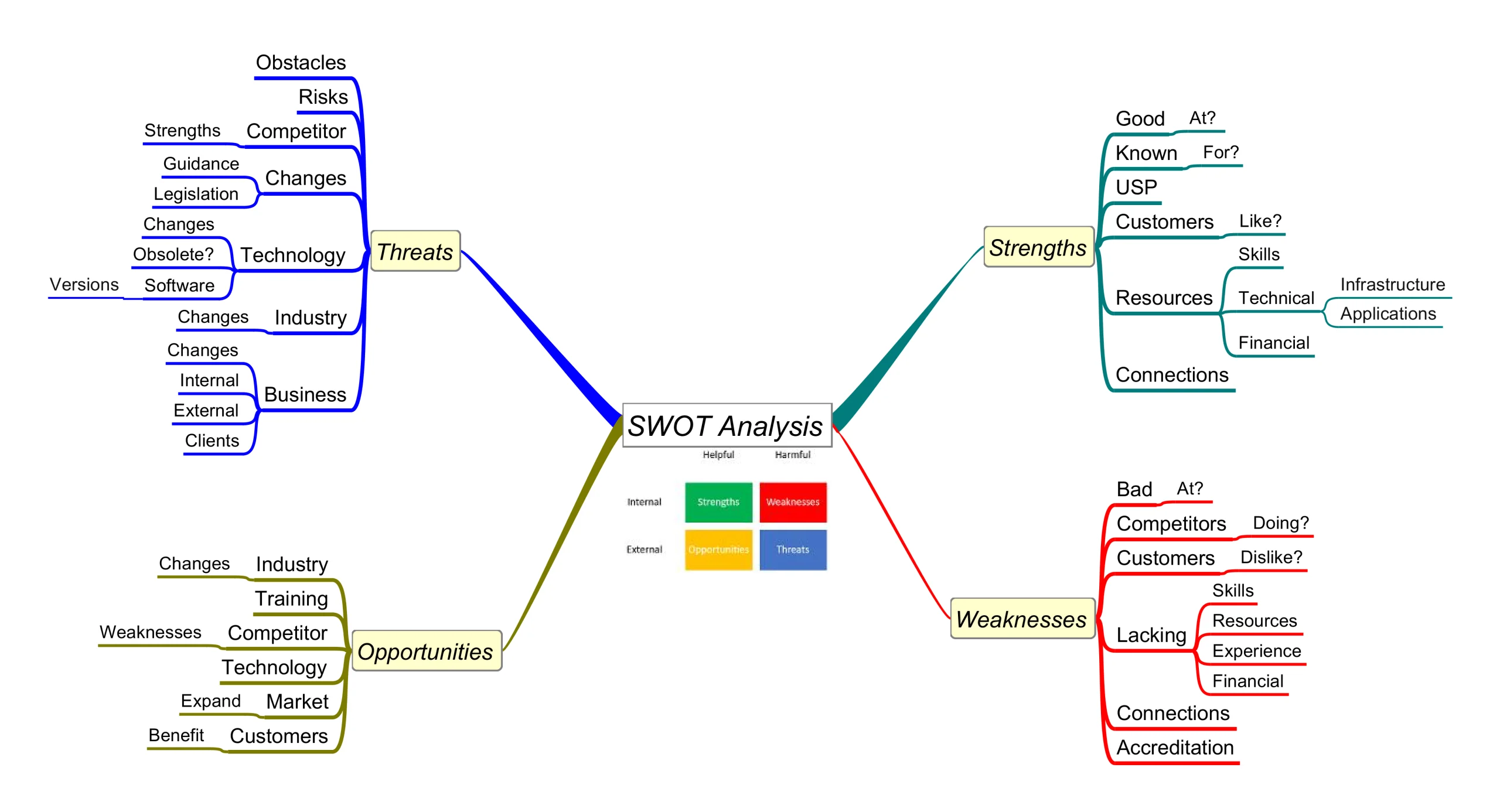A mind map is a powerful visual diagram that represents ideas, tasks, or other items linked to and arranged around a central key concept. Its structured nature helps users better analyze, comprehend, and generate new ideas. Leveraging mind maps for strategic analysis, especially within a SWOT framework, can reveal multiple potential insights, including:
- Identifying Relationships: Mind maps reveal relationships and connections between different elements.
- Highlighting Gaps: The format can highlight gaps in knowledge or resources.
- Spotting Opportunities: It enables quick identification of underlying issues and potential opportunities.
- Holistic View: Offers a comprehensive view of project scopes or business strategies.
- Prioritization: Allows prioritization through visual emphasis on certain branches.
In this article, we will present a 5-level deep SWOT Analysis Mind Map, offering a structured overview of an organization’s strategic position.
What Is a Mind Map?

A mind map is a visual representation of hierarchical information that organizes data in a way that is easy to comprehend. At the center of a mind map is the main concept or idea. From there, branches radiate outward, representing related subtopics. Each branch may also include further subtopics, leading to a comprehensive visualization.
In the case of a SWOT analysis mind map, the central concept is the organization’s strategic position. This central theme expands into the four core categories of SWOT (Strengths, Weaknesses, Opportunities, Threats). Each branch then further subdivides into specific attributes, providing an organized layout.
Benefits of Using Mind Maps for SWOT Analysis
Mind maps are particularly advantageous for conducting a SWOT analysis due to their ability to represent relationships and prioritize strategic elements. Here’s why mind maps should be your go-to tool for SWOT analysis:
- Identify Relationships and Connections:
- The visual structure reveals interconnections between strengths, weaknesses, opportunities, and threats.
- Highlight Gaps in Knowledge or Resources:
- If strengths don’t align with opportunities or weaknesses correspond to threats, resource gaps become apparent.
- Spot Underlying Issues and Potential Opportunities:
- The clear structure helps identify underlying problems like resource limitations or highlight opportunities like market expansion.
- Provide a Holistic View:
- A unified visualization offers a comprehensive perspective of business strategies and project scopes.
- Enable Prioritization:
- Branches of significant importance can be emphasized, helping prioritize strategic focus areas.
Visualizing the Mind Map
For a visual representation, this mind map can be created using graphical mind mapping tools like XMind, MindMeister, or free online tools such as Coggle and FreeMind.
Graphical Example with XMind or Similar Tools
- Central Node: “SWOT Analysis” (representing the main strategic position).
- Primary Branches: “Strengths,” “Weaknesses,” “Opportunities,” and “Threats.”
- Secondary Branches: Further subdivision into categories like “Brand Recognition,” “Market Dependency,” etc.
- Tertiary Branches: More granular items like “Global Presence,” “Emerging Markets,” etc.
Using this structure, users can interactively explore relationships between the branches and identify strategic priorities.
Strategic Insights from the SWOT Mind Map
The above mind map provides a comprehensive structure for analyzing an organization’s strategic position through the following insights:
1. Relationships and Connections
The connections between branches, such as technological innovation (opportunity) and technological lag (weakness), can reveal how one aspect affects another. For instance, if an organization is experiencing rapid technological changes (threat) while simultaneously lagging technologically (weakness), it’s clear that this issue needs urgent attention.
2. Gaps in Knowledge or Resources
If certain strengths lack corresponding opportunities or weaknesses correlate with threats, it highlights areas where resources or knowledge may be missing. For instance, if “Brand Recognition” (strength) doesn’t align with “Market Expansion” (opportunity), it may indicate an untapped potential in marketing strategy.
3. Underlying Issues and Opportunities
Some branches can reveal fundamental issues like “Market Dependency” (weakness) alongside “Market Expansion” (opportunity), suggesting a strategic shift toward diversification.
4. Holistic View of Strategies
A well-constructed mind map offers a unified framework to understand an organization’s strengths, weaknesses, opportunities, and threats cohesively. Each element can be viewed in relation to others, providing a clear strategic position.
5. Prioritization through Emphasis
The hierarchical nature of mind maps allows prioritization by placing emphasis on critical branches, such as market expansion opportunities or cybersecurity threats.
A SWOT Analysis Mind Map provides a structured overview of an organization’s strategic position, making it easier for stakeholders to navigate and explore various aspects of the business environment and internal capabilities. This mind map format ensures that each component is explored thoroughly, offering strategic insights that can drive decision-making processes.
Key Takeaways:
- Visual Structure: Mind maps offer a clear visual structure to understand and analyze strategic positions.
- Interconnected Elements: Identifying relationships helps in uncovering underlying issues and opportunities.
- Comprehensive Overview: Provides a holistic and comprehensive framework for strategic analysis.
- Ease of Modification: Editable in Markdown or graphical mind mapping tools for greater flexibility.
Next Steps:
- Utilize the provided mind map template to build your own customized SWOT analysis.
- Involve key stakeholders in refining the map for strategic clarity.
- Leverage insights from the mind map to prioritize actionable strategies.
About Dawgen Global
Dawgen Global is a multidisciplinary professional service firm specializing in risk advisory, management consulting, audit, assurance, and legal services. Our team of experts provides tailored solutions that help businesses navigate complex strategic challenges, leveraging tools like mind maps for comprehensive analysis and insights.
Feel free to reach out to us for assistance in building strategic insights using the SWOT Analysis Mind Map or other visual frameworks. Email: [email protected]

